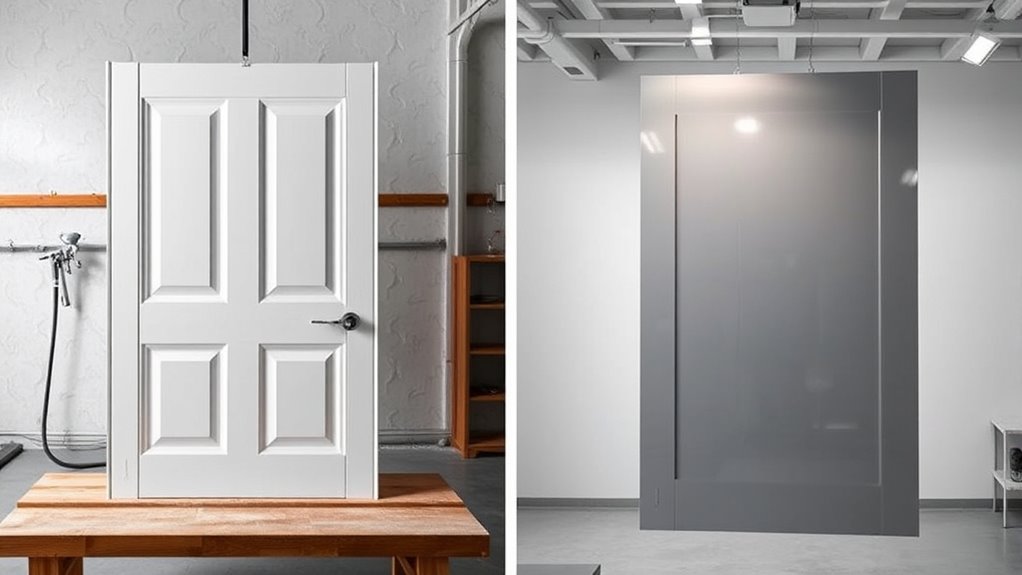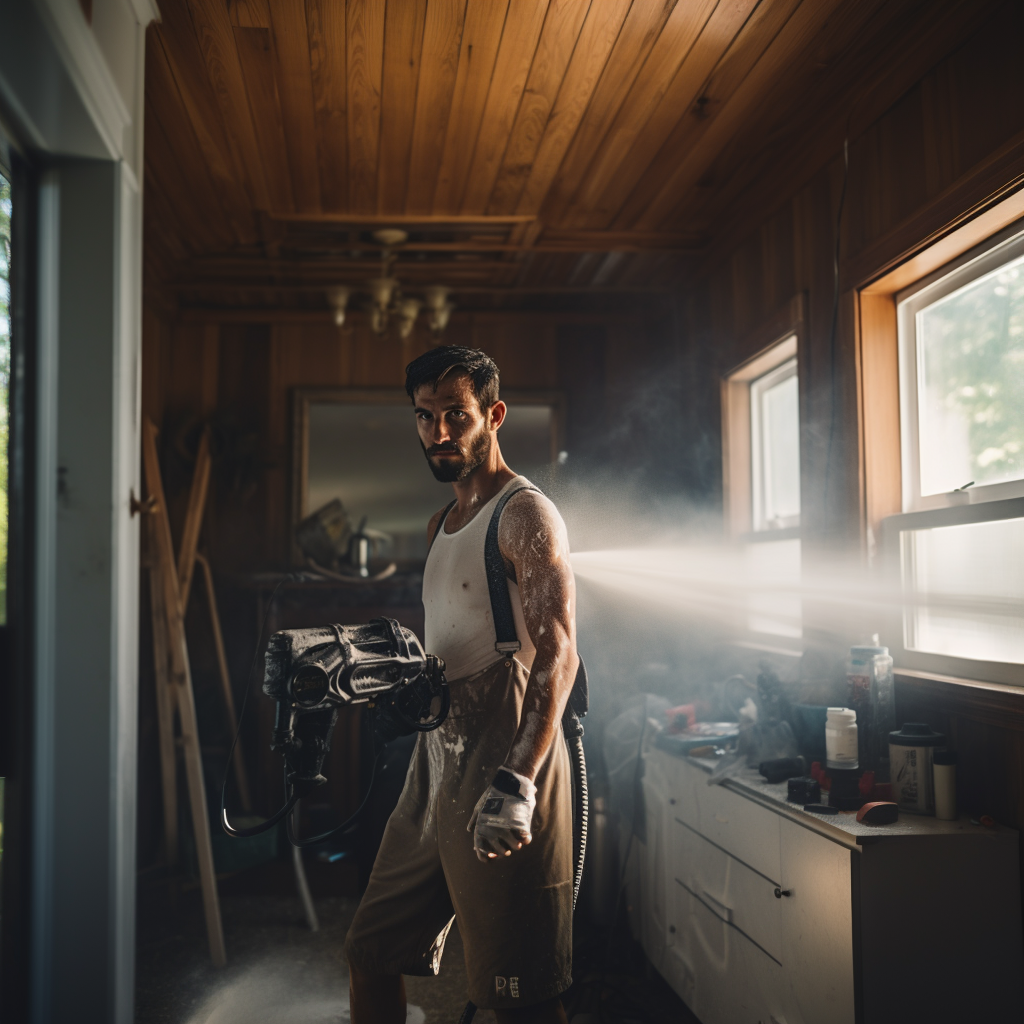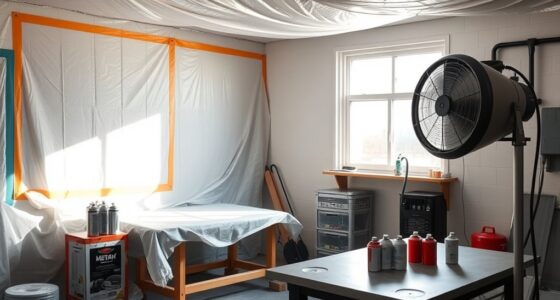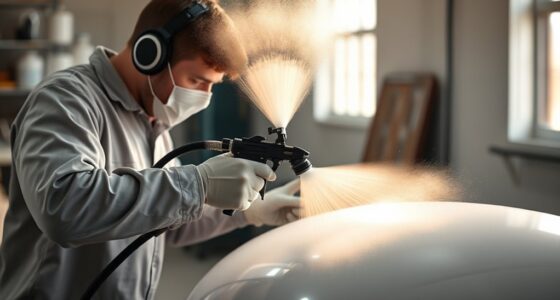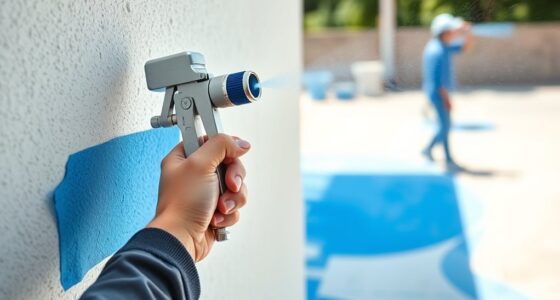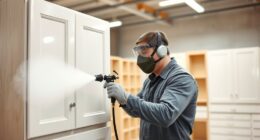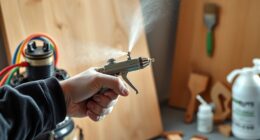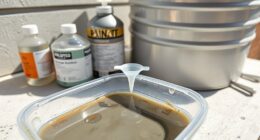When spraying doors, laying flat helps you keep dust off the surface and makes inspection easier for touch-ups, but it can take longer to dry and needs more space. Hanging doors allows for quicker, even drying and better air circulation, reducing the risk of smudges, but it requires secure hooks and careful setup. Each method has advantages, depending on your workspace and goals—continue for more details on choosing the best approach for your project.
Key Takeaways
- Flat laying provides better surface inspection and touch-up control, while hanging ensures more even drying and fewer contact marks.
- Hanging allows for quicker drying and easier access around the entire door surface, boosting workflow efficiency.
- Flat setup requires stable, level surfaces and more space, whereas hanging needs secure hooks and proper support for stability.
- Both methods benefit from dust-free, well-ventilated environments to prevent dust settling and uneven curing.
- Choice depends on workspace size, desired finish quality, and drying speed, with flat ideal for detail work and hanging for efficiency.
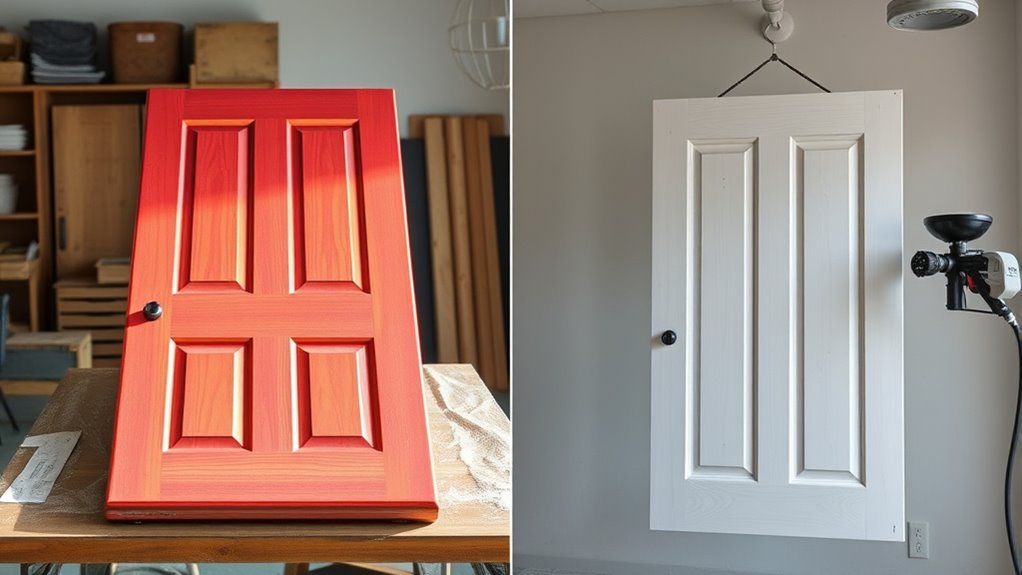
When it comes to spraying doors, choosing between laying them flat or hanging them is a key decision that can impact your finish. Your choice influences not only the quality of the coat but also the overall process, including spray booth setup and paint drying techniques. If you opt to lay the door flat, you’ll need to set up a stable, level work surface that allows you to access all areas easily. This setup helps prevent runs and drips since gravity isn’t pulling the paint down unevenly. It also makes it easier to inspect the surface for imperfections and touch up as needed. However, laying the door flat can be more time-consuming for drying, especially if you don’t have a dedicated space where the entire door can rest without contact. Proper paint drying techniques become vital here; you want to keep the door in a dust-free environment, away from airflow that might disturb the wet paint. Using a well-ventilated spray booth setup facilitates even drying, reducing the risk of dust settling on the surface or uneven curing. Additionally, proper drying techniques are essential to avoid smudges or damage to the freshly painted surface during the curing process.
On the other hand, hanging doors offers advantages in terms of workflow and efficiency. When you hang a door, you can move around it freely, applying even coats without worrying about the surface touching anything or accumulating dust. This setup also allows for more efficient drying, as the air can circulate around the entire door, promoting uniform paint curing. To get the best results, you should ensure your spray booth setup includes proper hooks or hanging points that keep the door stable and free of contact with other surfaces. Hanging doors reduces the risk of fingerprints or smudges on the painted surface, especially during drying. Still, it requires careful attention to your paint drying techniques; you want to prevent the paint from stretching or pulling unevenly, which can happen if the hanging points aren’t secure or if the environment isn’t controlled.
Ultimately, your choice depends on your workspace, tools, and preference. Laying the door flat offers better control over touch-ups and detailed work, but drying time can be longer. Hanging the door speeds up the process and encourages even drying, but it demands a stable setup to avoid imperfections. Whichever method you choose, focusing on a proper spray booth setup and effective paint drying techniques is essential to achieve a smooth, professional finish.
Frequently Asked Questions
Which Method Offers Faster Drying Times, Lay Flat or Hang?
Hanging doors generally offers faster drying times because it improves drying efficiency by allowing air to circulate evenly around the paint. When you hang a door, the paint isn’t affected by gravity, resulting in a more consistent paint thickness and quicker drying. Laying doors flat can trap moisture and slow down drying. So, for faster results, hanging your doors is usually the better option.
How Do Surface Imperfections Affect Each Spraying Technique?
Surface flaws can turn your spray job into a rough road. If imperfections like bumps or cracks are present, they can cause uneven paint adhesion, leading to drips or missed spots. When you spray doors lay flat, gravity can make flaws more noticeable, while hanging might help hide minor surface imperfections. To achieve a smooth finish, guarantee surface flaws are sanded or filled before spraying, regardless of your method.
Can Both Methods Be Used on Textured or Detailed Door Surfaces?
Yes, both methods work on textured surfaces and detailed finishes. If you spray on a textured surface, hanging the door allows gravity to help achieve even coverage, especially on intricate details. Laying the door flat is better for detailed finishes, preventing drips and pooling. Consider the surface’s complexity and your preferred finish, then choose the method that gives you the best control and results for textured or detailed surfaces.
What Safety Precautions Are Necessary for Each Spraying Method?
When spraying doors, you need to wear protective gear like masks, goggles, and gloves to avoid inhaling fumes or getting paint on your skin. Make certain proper ventilation by opening windows or using fans, especially when spraying in enclosed spaces. For lay flat methods, keep the area well-ventilated and avoid overexposure. Hanging doors also require attention to ventilation to prevent buildup of fumes and ensure safety during the process.
How Does Each Technique Impact the Longevity of the Finish?
Hanging doors often results in better finish durability and surface adhesion, as gravity helps the coating settle evenly and reduces runs. Conversely, laying doors flat can sometimes cause uneven drying, risking cracks or peeling over time. If you want a long-lasting, durable finish, hanging the door tends to be the better choice, ensuring consistent application and minimizing flaws that compromise the finish’s longevity.
Conclusion
Whether you choose to lay your doors flat or hang them, each method has its perks and pitfalls. Laying doors offers stability and easier access, but risks drips and dust settling. Hanging doors saves space and prevents contact with surfaces, yet can be tricky to hang evenly. Ultimately, your choice depends on your workspace and priorities. Weigh these factors carefully, and you’ll find the best method to achieve a smooth, flawless finish—whether lying flat or hanging high.
Franz came aboard the Paint Sprayer Zone team with a background in both journalism and home renovation. His articulate writing style, combined with a passion for DIY projects, makes him an invaluable asset. Franz has a knack for breaking down technical jargon into easy-to-understand content, ensuring that even the most novice of readers can grasp the complexities of paint sprayers.
